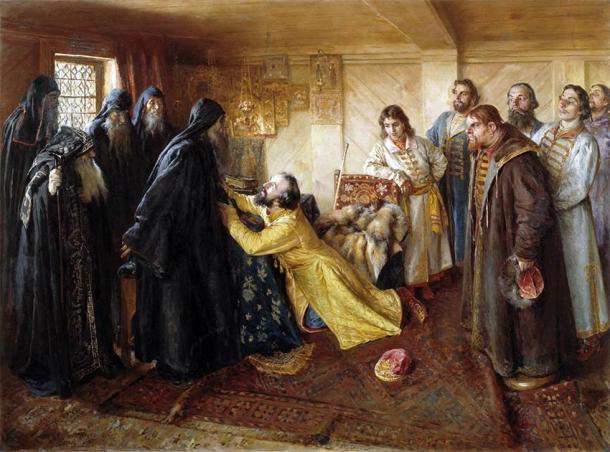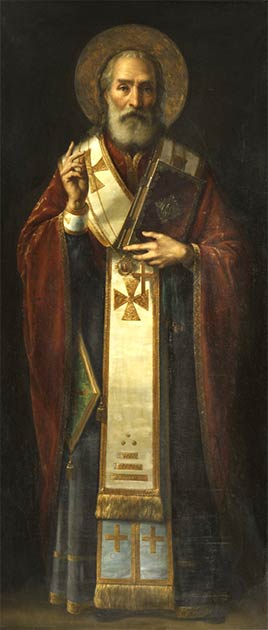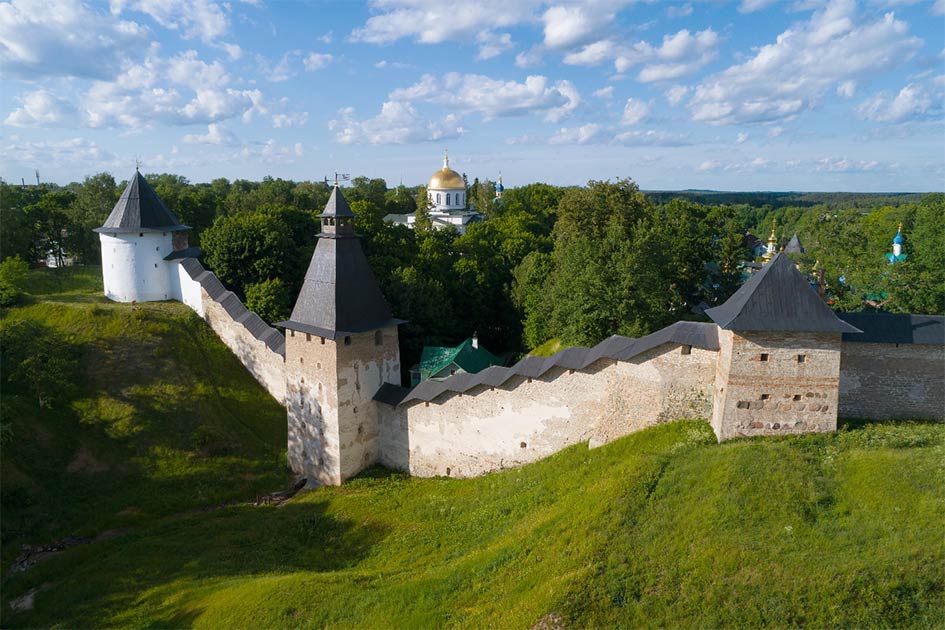The Pskov-Caves Monastery and its 10,000 Monk Necropolis
The Pskov-Caves Monastery is a Russian Orthodox monastery located in the town of Pechory, in the northwestern part of Russia. The monastery was established during the 15th century AD and is well-known for a number of reasons. For a start, it is an important spiritual center for the Russian Orthodox Church. Additionally, it served a military function, being a stronghold that defended the western frontier of Russia. Thirdly, the Pskov-Caves Monastery is one of the few monasteries in Russia that was able to maintain its operations during WWII and throughout the Soviet regime.
The History Of The Pskov-Caves Monastery
The Holy Dormition Pskovo-Pechersky Monastery, often shortened to the Pskov-Caves Monastery, and known also as the Pechory Monastery, is located in Pechory, a town in Russia’s Pskov Oblast. This town is situated about 50 km (31 mi) to the west of Pskov, and just a few kilometers from Russia’s border with Estonia.
Officially, the date of the monastery’s foundation is the 15th / 28th of August 1473 AD. On that day, Saint Jonah (Shesnik), the founder of the monastery, consecrated the Church of the Dormition of the Most Holy Mother of God, the first church incidentally built into the hillside of the monastery complex. It may be argued, however, that the monastery began its life earlier than that, i.e. around the middle of the 15 th century AD, as hermits started living in the local caves at that time.
In the years that followed, the Pskov-Caves Monastery grew and prospered, reaching its heyday during the abbotship of Saint Cornelius in the 16th century AD. Cornelius was born in 1501 AD in Pskov. His parents, Stephen and Mari, belonged to the nobility, and had the means to provide him with a good education. At a young age, Cornelius was sent to the Pskov Mirozh Monastery, where he was placed under the guidance of an elder. In addition to learning to read, Cornelius’ studies at the monastery included making candles, transcribing and adorning manuscripts, and painting icons. When he had completed his studies, Cornelius returned to his parents’ home, but with the firm intention of becoming a monk.
On one occasion, a government clerk by the name of Misiur Munekhin took Cornelius to the Pskov-Caves Monastery with him. The visit made such a strong impression on Cornelius that he left his parents’ home for good and received the monastic tonsure at the Pskov-Caves Monastery.

A painting of Saint Cornelius, who contributed so much to the greatness of the Pskov-Caves Monastery. (John Sanidopoulos blog site)
The Incredible Achievements Of Saint Cornelius
In 1529 AD, when Cornelius was 28 years old, he was raised to the office of hegumen (a role similar to that of an abbot), and under his leadership, the Pskov-Caves Monastery flourished like never before. This is seen, for instance, in the number of monks, which increased from 15 to 200. This number was not surpassed by any other hegumen that succeeded Cornelius. Many other achievements were made by the Pskov-Cave Monastery under Cornelius’ leadership.
One of the most significant of these was the transformation of the Pskov-Caves Monastery into a center for the propagation of religion and knowledge. For example, the saint created a library for the storage of manuscripts, established chronicling, and founded a workshop dedicated to the painting of icons. Furthermore, missionaries set out from the monastery to spread the Orthodox faith to the neighboring Seto people, who had not yet been fully converted to Christianity at that time. Thus, the Pskov-Caves Monastery is still considered by the Seto as an important spiritual center.
In addition to preaching to the Seto, the missionaries from the monastery also built churches, hospices, and homes for orphans and those in need. Cornelius himself is said to have performed these works of charity. According to one story, when the plague struck Pskov, Cornelius walked through a plague-infested village to give Communion to the living, and to sing burial services for the dead.

The monastery’s Church of Saint Nicholas was commissioned during the time Saint Cornelius was head of the monastery. (GAlexandrova / CC BY-SA 4.0)
Apart from that, Cornelius made important architectural additions to the monastery complex. The Church of the Annunciation and the Church of Saint Nicholas were built during Cornelius’ time, as were the stone walls with bastions that surrounded and fortified the monastery. These defensive structures were constructed between 1558 and 1565 AD, as the monastery was located on the western borders of Russia and was constantly at risk of being attacked by foreign enemies. Moreover between 1558 and 1583 AD, Russia was engaged in the Livonian War, which meant that the situation at the monastery was even more precarious.
Despite the war, Cornelius found opportunities to perform acts of charity. In addition to preaching Christianity in the occupied towns, the saint also distributed food from the monastery’s storerooms to those affected by the war, and opened to gates of the monastery to refugees, who were fed and nursed back to health.
- Geghard Monastery: Ancient Guardian of the Lance that Stabbed Jesus?
- An 8-Hour Walk to Get Groceries: This Monastery is so Remote That Almost No One Has Heard About It
- The Monastery of Saint Catherine: A Controversial Agreement Across Faiths
Cornelius died on the 20 th of February 1570 AD. According to tradition, some envious people slandered the hegumen in front of the tsar, Ivan the Terrible. Believing the slanderers, Ivan became furious, and went to the Pskov-Caves Monastery to meet Cornelius. Hearing of the tsar’s arrival, the saint went out of the monastery with a cross to meet him. Ivan, however, beheaded Cornelius with his own hands. Immediately, the tsar regretted his action, and carried Cornelius’ body to the Church of the Dormition. This path became known as the “Bloody Path.” The tsar’s remorse is also evident in the generous endowment he made to the monastery after Cornelius’ murder.

Tsar Ivan the Terrible asks hegumen Kornily to admit him as a monk in the monastery after feeling incredible remorse for murdering Saint Cornelius. (Klavdy Lebedev / Public domain)
The Pskov Caves Necropolis
The body of Cornelius was buried in the “Caves Given by God,” which are part of the monastery. Legend has it that during the 14th century AD, local hunters heard angelic singing and smelled a fragrance emanating from the caves, which are situated in a hill. Naturally, they thought that there were angels in the caves.
Years later, the caves were opened when a farmer chopped down a tree that fell down the hill. When the farmer went to inspect the opened cave, he saw above the entrance an inscription with the words “Caves Given by God.” Following the establishment of the Pskov-Caves Monastery, the caves were used as a necropolis for the burial of the monks. It is estimated that the necropolis now contains the remains of about 10000 monks. Whilst the caves are today opened to pilgrims and visitors, they can only be visited with a local guide.

The interior of the limestone Pskov Caves, a necropolis for deceased monastery monks. (Pskovgo Narod)
The fortifications built by Cornelius served the monastery well not only during the 16 th century AD, but also in the following century. Poles, Lithuanians, Swedish, and Germans attacked the monastery at one time or another, but each time they were repelled. Some might even attribute the monastery’s survival to divine protection. For instance, Cornelius entrusted the protection of the monastery to Saint Nicholas, and in the church dedicated to this saint is a wooden icon of Saint Nicholas the Warrior.

Saint Cornelius entrusted the protection of the Pskov-Caves Monastery to Saint Nicholas, who is pictured here. (Galerie Art Praha / Public domain)
Further support for this idea of divine protection may be seen in the history of the Pskov-Caves Monastery during the 20th century AD. In 1920 AD, the town of Pechory was given to Estonia, in accordance with the Treaty of Tartu. Thus, the monastery was outside Russian territory in the decades up to WWII.
Consequently, the monastery was saved from destruction by the Soviets. The monastery also survived WWII and is one of the few monasteries in Russia to have continued functioning during WWII and during the Soviet period.
The monastery reached a milestone in 2013 AD, when it celebrated the 540th anniversary of its founding. It is likely that the Pskov-Caves Monastery will continue to function for many more years to come. As stated on the monastery’s website, “The years pass, governments and empires rise and fall, but the monastery ever remains a firm stronghold of Orthodoxy in a restless world.”
Top image: The defensive walls surrounding the Pskov-Caves Monastery on a sunny June day. Source: sikaraha / Adobe Stock
By Wu Mingren
References
Ahvenas, 2020. Pskov-Caves Monastery. [Online]
Available at: https://www.atlasobscura.com/places/pskov-caves-monastery-pskovo-pechersky
Derzhavina, V., 2019. Baroque churches and gloomy caves of Pechory Monastery. [Online]
Available at: https://www.itinari.com/baroque-churches-and-gloomy-caves-of-pechory-monastery-ugzp
Rzhevsky, S., 2017. Pskov-Caves Monastery – a unique architectural complex. [Online]
Available at: https://russiatrek.org/blog/regions/pskov-caves-monastery-a-unique-architectural-complex/
The Orthodox Church in America, 2020. Beheading of Venerable Cornelius, Abbot of the Pskov Caves. [Online]
Available at: https://www.oca.org/saints/lives/2018/02/20/100571-beheading-of-venerable-cornelius-abbot-of-the-pskov-caves
www.pskovo-pechersky-monastery.ru, 2020. The holy dormition Pskov-Caves Monastery. [Online]
Available at: https://www.pskovo-pechersky-monastery.ru/eng


















Comments
Hi All,
About St. Cornelius the article mentioned that the Monk painted icons did that include the painting of a two-headed Eagle with I think four wing's? I saw this two-headed Eagle on other Russian Orthodox Church Walls.
That's all I wanted to know. Until next time Everyone, Goodbye!